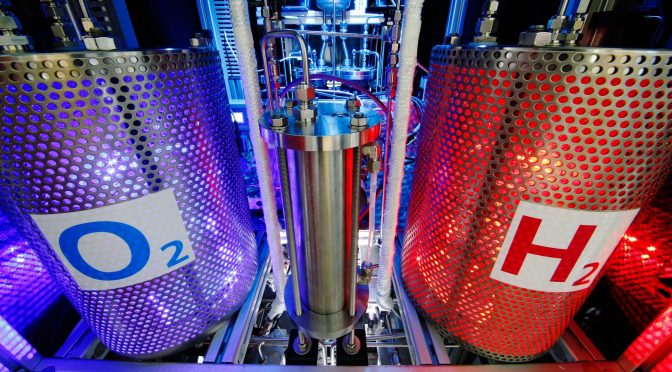Naturgy and Enagás are studying the production of green hydrogen from a 250-MW floating offshore wind farm and another 100-MW onshore wind farm in Asturias for industrial consumption in this Autonomous Region. The project is a candidate Important Project of Common European Interest (IPCEI) and makes it possible to generate green hydrogen using local energy resources for added value.
Specifically, the project envisages developing an electrolysis and renewable energy plant with the construction of an onshore and an offshore wind farm on the coast of Asturias. The latter will be built with floating technology developed by the Navantia-Windar temporary joint venture, with up to 24 platforms for generating renewable energy. The initiative will lead to progress in energy transition by favouring the decarbonisation of sectors such as steel and shipyards, also extending to other sectors by injecting renewable hydrogen into the gas network.
This project could create a total of more than 1,500 jobs during its construction and operation phases and, thanks to the estimated renewable power production, expects to initially save more than 200,000 tonnes of CO2 emissions per year.
The technology will first be deployed on a demo scale with 50 MW offshore and 100 MW onshore wind power, as well as a 5-MW offshore electrolyser and another 100-MW onshore electrolyser. During the second phase, the project could be extended up to 250 MW offshore wind power with an additional 100-MW onshore electrolyser.
The project will provide experience in the large-scale integration of electrolysis and renewable energy, both onshore and offshore, and will also allow for progress in reducing green hydrogen production costs.
The green hydrogen will be consumed locally, distributed through the gas network and exported to Europe, thus establishing the first large-scale European green hydrogen production and transport chains to decarbonise sectors and strengthen the European energy system, positioning Spain as a producer and exporter. With this, we can make progress in the different alternatives for long-distance green hydrogen transport, as well as in the use of gas infrastructures, whether by blending or by reconverting these infrastructures in the long term.
Therefore, local industries will also benefit from the project as the hydrogen can be mixed with natural gas and marketed using Guarantee of Origin mechanisms, thus allowing for the decarbonisation of sectors that are difficult to electrify without having to undertake investments in the short-medium term that can reduce their competitiveness.
As the main players in the Spanish gas sector, Enagás and Naturgy are destined to play a key, relevant role in energy transition as driving forces for developing the green hydrogen value chain. This energy carrier is capable of channelling great quantities of renewable energy to sectors where electrification is not a viable option, and also makes it possible to store and manage energy on a mass scale for extended periods of time, matching energy supply and demand.
Hydrogen development
Enagás and Naturgy are aware of the importance of the Principality of Asturias in the context of energy transition. They participate in the Hydrogen Panel launched by this Autonomous Region in order to help the region’s industry incorporate renewable gases, especially hydrogen, into its productive economy, leveraging the innovation and development capabilities of Asturias and the positioning and presence that both Enagás and Naturgy already have in the territory.
Naturgy has been researching hydrogen development for years as this renewable resource, the existing infrastructure and our geostrategic position mean that Spain has high potential to become a hydrogen exporter in the future. This new energy can be exported using the current gas infrastructure, which would allow us to integrate the electricity and gas networks, obtaining a more efficient and resilient energy system.
For Enagás, this project is part of its strategy for the development of non-electric renewable energy, green hydrogen and biogas/biomethane as new energy solutions that will play an essential role in the energy transition process set out by the European Union. Enagás is the main gas transporter and operator in Spain; one of its main objectives is to develop and facilitate export routes and key projects in this area so we can position Spain as a leader in this sector.
In a context where hydrogen is currently marketed worldwide, long-distance liquid hydrogen transport and distribution (as with LNG) could be key, and both Enagás and Naturgy play an essential role by contributing their capacity and expertise throughout the value chain.


